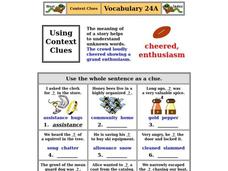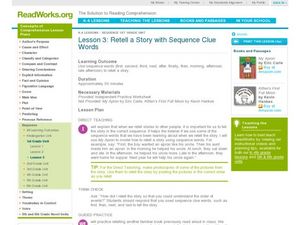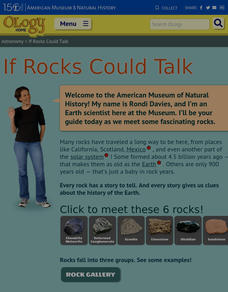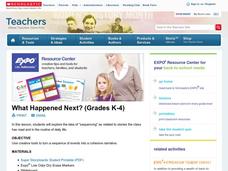Curated OER
Context Clues
In this context clues worksheet, students read the sentences and use context clues to determine which word best completes the sentence. Students complete 8 sentences.
Curated OER
Sentence Clues
In this context clues activity, students read the sentences and use the red highlighted phrase as a clue to select the correct answer. Students complete 8 sentences.
Curated OER
Guided Reading with I Had a Hippopotamus
Students discuss animals that would make good pets and a kind of pet that might scare someone in their family. They view the cover of the book and predict what the book might be about. They tell the story based on looking at the...
Curated OER
SWOOP Reading
First graders read fluently. In this phonics lesson students practice reading strategies for fluency. They write a response in their journal about the book read in class.
Curated OER
Using New Vocabulary in Context
Sixth graders analyze new vocabulary from a narrative. In this vocabulary lesson, 6th graders read a narrative and create a paragraph as a group using words from the text. Students then create another paragraph using the vocabulary...
Curated OER
Shh! I am Trying to Read!
Students explore the advantages of being able to read silently. They then review a "stuck on a word" strategy using context clues to determine meanings of unknown words. They then practice reading silently and the teacher assesses for...
Curated OER
Vowels, Reading Fluency
Third graders practice identifying words with the short o vowel sound. They use the strategy will reading a page from The Hare and the Tortoise. They read the passage while focusing on increasing their reading fluency and practice...
Curated OER
Lesson 3: Retell a Story with Sequence Clue Words
First graders evaluate sequence words. In this order of events lesson plan, 1st graders practice using sequence words to retell a story. They do guided practice with the teacher retelling a story they have read as a class and then try it...
Kimskorner4teachertalk
Foreshadowing
Take a look at foreshadowing in any text by recording instances of foreshadowing in a straightforward graphic organizer. Learners note down the event, the clue, and the page number for five foreshadowed events. There is also space for...
Book Units Teacher
Skill Lessons – Prefixes and Suffixes
Sometimes the best way to understand a concept is to break it down. Young vocabulary pupils work with word parts in a hands-on activity that prompts them to connect flash cards with affixes to their root and base words. Additionally,...
US Environmental Protection Agency
Tree Rings: Living Records of Climate
Open with a discussion on weather and climate and then explain how tree rings can provide scientists with information about the earth's past climate. Pupils analyze graphics of simulated tree rings from various US locations for the...
American Museum of Natural History
If Rocks Could Talk
Meet some interesting rocks. Learners discover information about the three types of rocks and different rocks that are within each group. They read imaginary interviews with six rocks as each rock tells the story of their formation and a...
CPO Science
The Periodic Table
Here is a six-page exploration that will spark interest in the periodic table of elements. After reading a diagram-supported explanation of the periodic table's organization, pupils answer questions to familiarize themselves with it. To...
EngageNY
Building Background Knowledge: The Dinka and Nuer Tribes Until the Mid-1980s (“Sudanese Tribes Confront Modern War” Excerpt 1) (Version 1)
Readers consider comparisons between the Dinka and Nuer tribes in South Sudan, making connections between an informational article about Sudanese tribes and the novel A Long Walk to Water by Linda Sue Park. They annotate the text to help...
Gourmet Curriculum Press
James and the Giant Peach
Here is a 19-page sample lesson that uses an interesting format. It starts with an appetizer or activity to make reading the book James and the Giant Peach fun. Then it dives into the main course or core content instruction which...
Beth Kupper-Herr
Taking Notes
When you ask your students to take notes during class, do they really know what you mean? Are they taking the right kind of notes and using their time effectively? Make sure they are by offering this handout, a comprehensive guide and...
Florida Center for Reading Research
Phonological Awareness - Phoneme Segmenting and Blending, Treasure Chest
Working in pairs, scholars use picture cards to practice segmenting words into phonemes and blending phonemes into words. When a peer answers correctly they place a penny in a treasure chest. Incorrect responses make the card go back in...
Florida Center for Reading Research
Vocabulary: Word Meaning, Defining Depictions
A picture is worth a thousand words! Young learners use the included templates to demonstrate their understanding of target vocabulary by creating pictures that depict their meaning.
Savvas Learning
"The Digestive Process Begins" and "Final Digestion and Absorption"
Want your class to digest text more thoroughly? Middle schoolers learn about the digestive system in the lesson and reinforce informational text reading skills through a variety of strategies. They engage in a close reading approach,...
Curated OER
Identifying Personification in Poetry
Improve your young poets' descriptive writing with this lesson on personification. A SMART board and PowerPoint presentation guide your class through the process of identifying human qualities attributed to various non-human objects. A...
Scholastic
What Happened Next? (Grades K-4)
Explore the structure of narrative writing with this fun, collaborative lesson. Start by reading aloud a short story, asking small groups of learners to fill in key events on a large story board prepared on the class whiteboard....
Weebly
Holocaust Diary Project
Here is a good interdisciplinary project that combines creative and narrative writing with studies of the Holocaust. Your young historians will compose a diary of experiences from the perspective of an individual living during the time...
K12 Reader
Appositive Hunt
How do you find appositives? Why you look for clues, those words or phrases, set off by commas, that tell readers more about nouns. Young grammarians can practice finding them with this worksheet.
Novelinks
The Giver: Biopoem
The characters in Lois Lowry's The Giver are rich and complex as they weave their way through the plot. Examine the character traits of one chosen person with a biopoem, which enables learners to follow a poetic format in writing a...

























